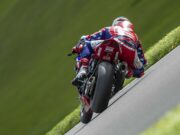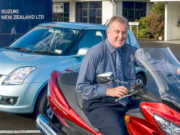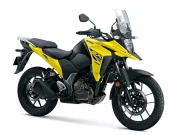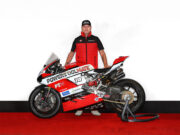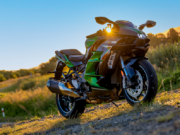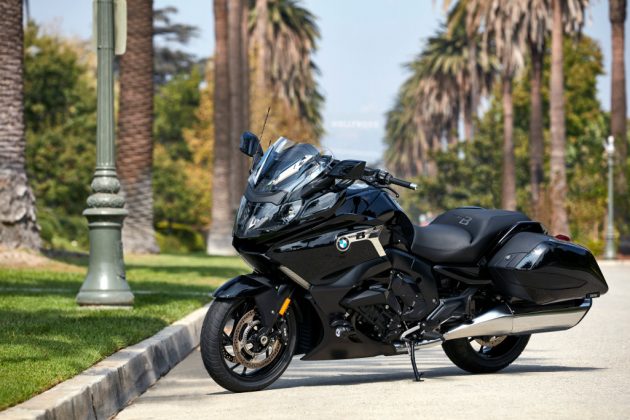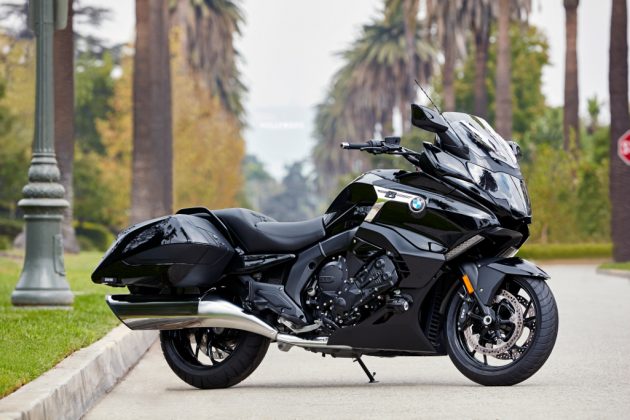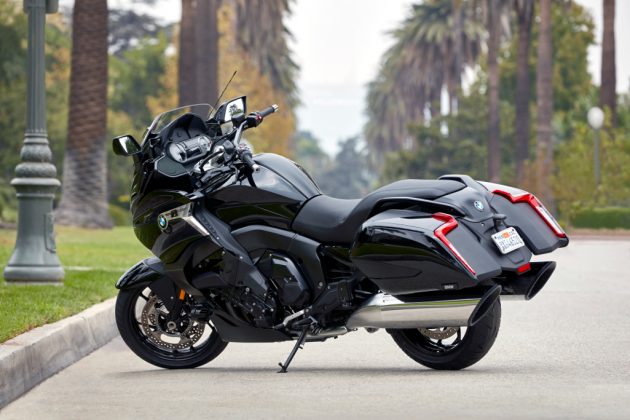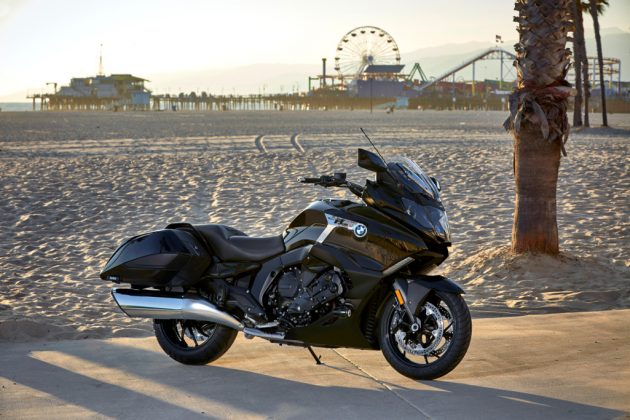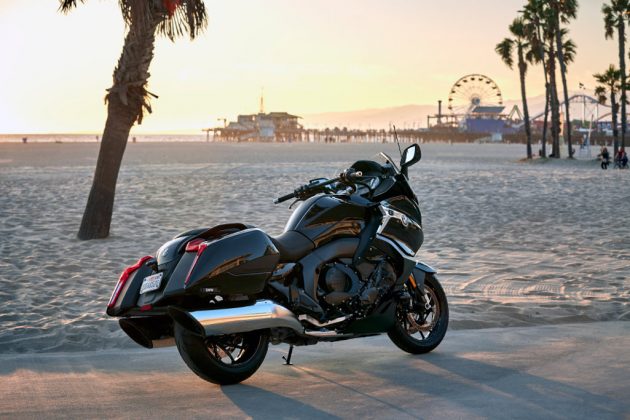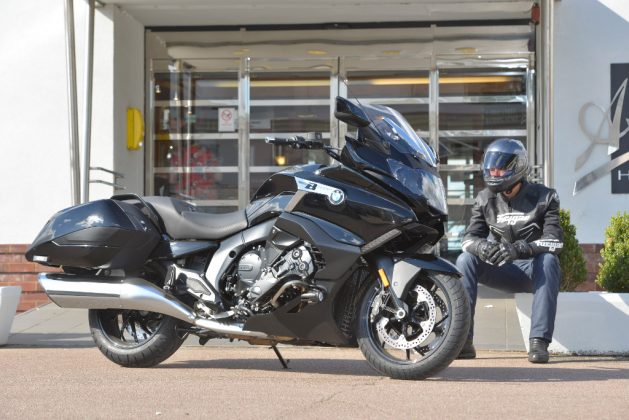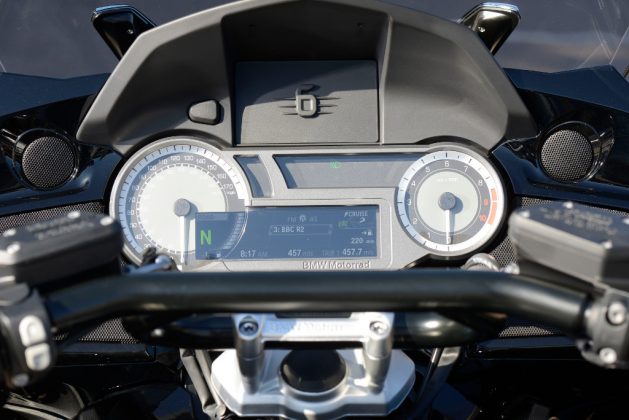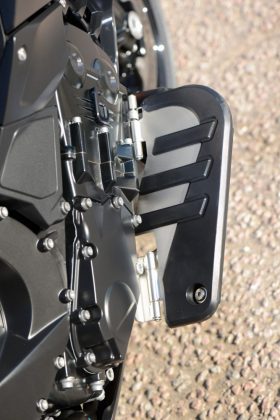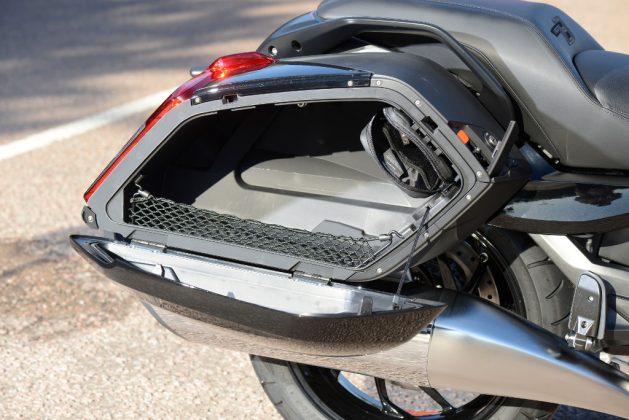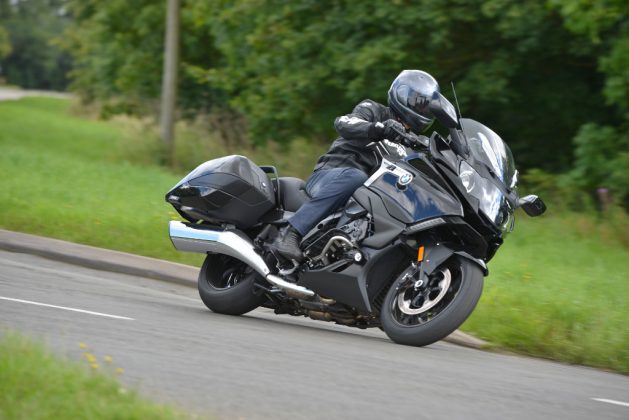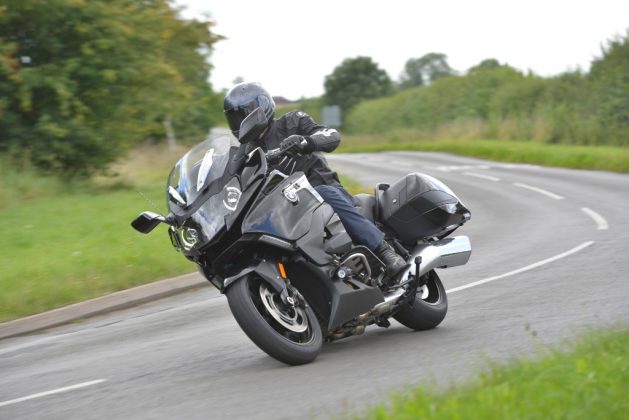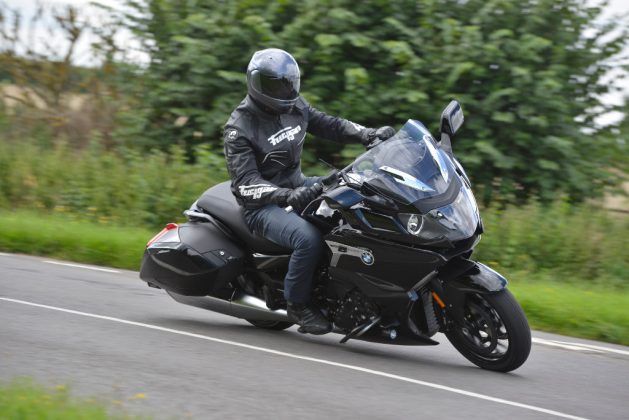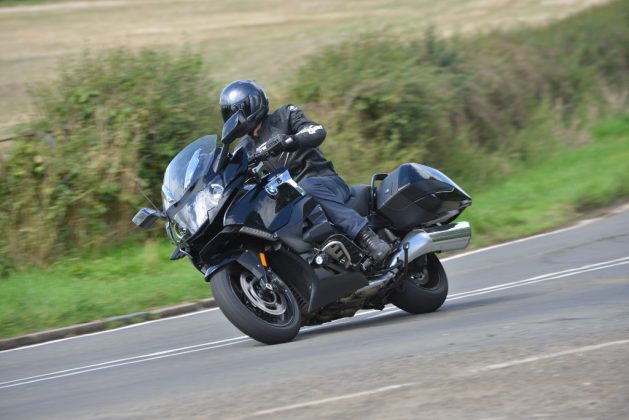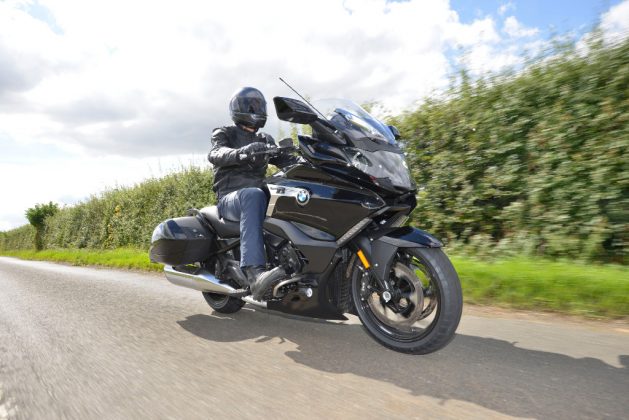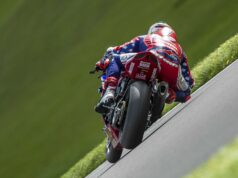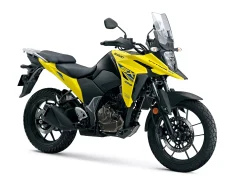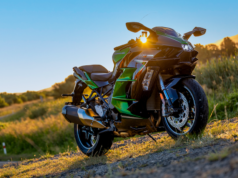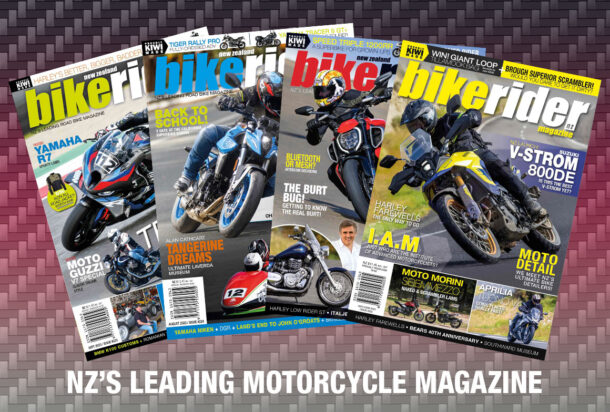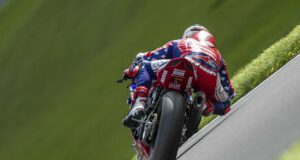Roland Brown gets behind the massive fairing of BMW’s latest 6-cylinder mile-muncher – the K1600B
Words: Roland Brown Pics: Mark Manning
There’s sunshine on my back, water to my left, and a twisty road stretching out ahead as the big BMW cranks through a curve before accelerating with another breathtaking burst of six-cylinder power. For a moment I could almost be in California, aiming the Concept 101 bagger up the Pacific coast along the Highway 101 after which it was named.
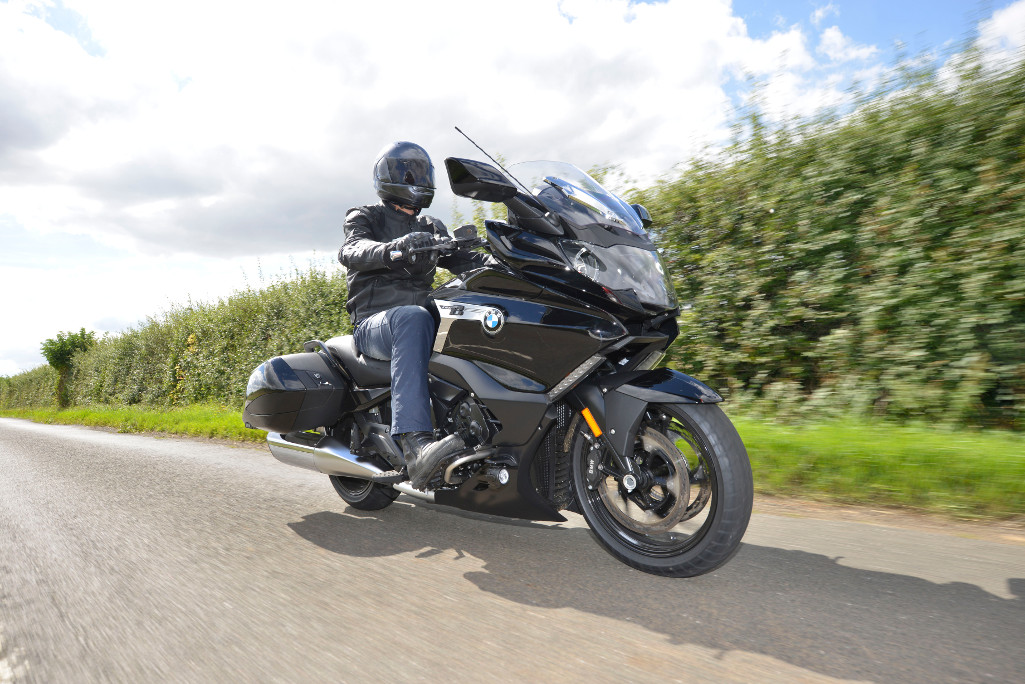 The reality is more down-to-earth. This is not Highway 101 but a narrow minor road running alongside a lake in the English Midlands. And instead of the stunning concept machine that BMW unveiled two years ago at the Concorso d’Eleganza Villa d’Este in Italy, I’m riding the K1600B – essentially the production version of that hand-built, Roland Sands assisted creation.
The reality is more down-to-earth. This is not Highway 101 but a narrow minor road running alongside a lake in the English Midlands. And instead of the stunning concept machine that BMW unveiled two years ago at the Concorso d’Eleganza Villa d’Este in Italy, I’m riding the K1600B – essentially the production version of that hand-built, Roland Sands assisted creation.
The K1600B is far from the first recent BMW to follow a concept model unveiled at the fancy show near Como. You might recall the stunning orange Concept 90 that led to the R nineT in 2014, and the racy Concept Roadster that preceded the R1200R. BMW’s strategy seems to be to introduce a striking prototype to gauge reaction and generate interest, then follow with a showroom machine a couple of years later.
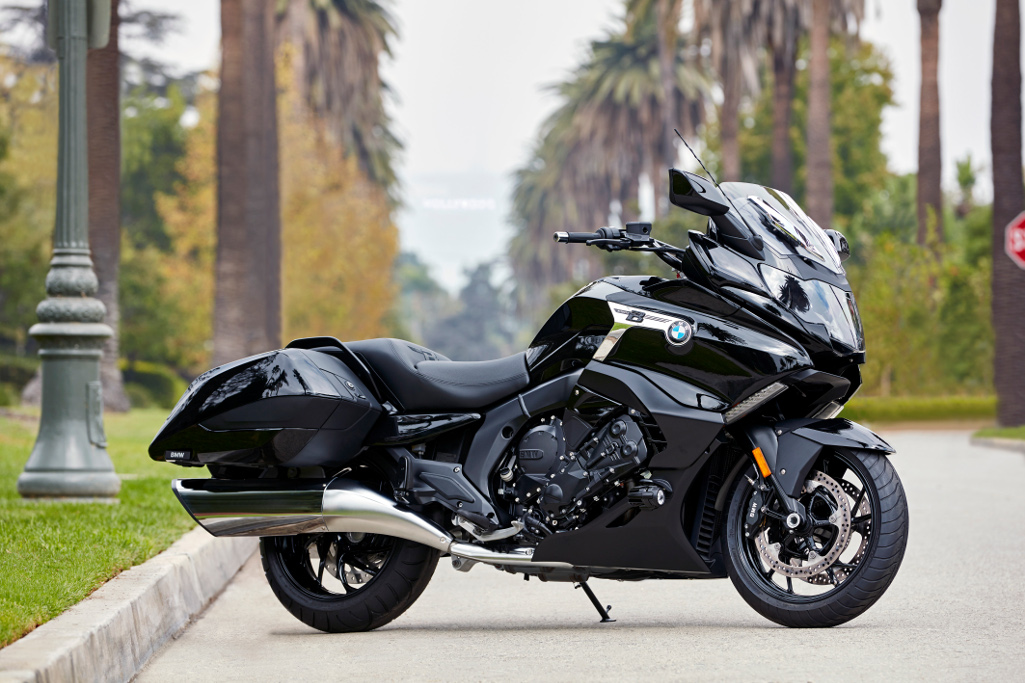 In this case, Concept 101 was developed at BMW’s Designworks studio in California, close to Highway 101 (the name also signifies the roughly 101 cubic-inch capacity). It was described by BMW as the “perfect embodiment of American touring”, and by the firm’s design chief Edgar Heinrich as “the epitome of elegance, power and luxury on two wheels”. That generated plenty of expectation for the production-ready follow-up, which comes only in black paintwork, and without the prototype’s brushed aluminium and polished walnut.
In this case, Concept 101 was developed at BMW’s Designworks studio in California, close to Highway 101 (the name also signifies the roughly 101 cubic-inch capacity). It was described by BMW as the “perfect embodiment of American touring”, and by the firm’s design chief Edgar Heinrich as “the epitome of elegance, power and luxury on two wheels”. That generated plenty of expectation for the production-ready follow-up, which comes only in black paintwork, and without the prototype’s brushed aluminium and polished walnut.
The K1600B also has a taller screen and more conventional exhaust system than Concept 101, but it looks similar in most respects and has some of the California-cool vibe that somehow only a low-slung rear end can generate. Essentially, this latest in the K-series line is the recently revamped K1600GT tourer, modified with a shorter screen, lowered rear end and one-piece drag handlebar instead of the GT’s similarly positioned clip-ons.
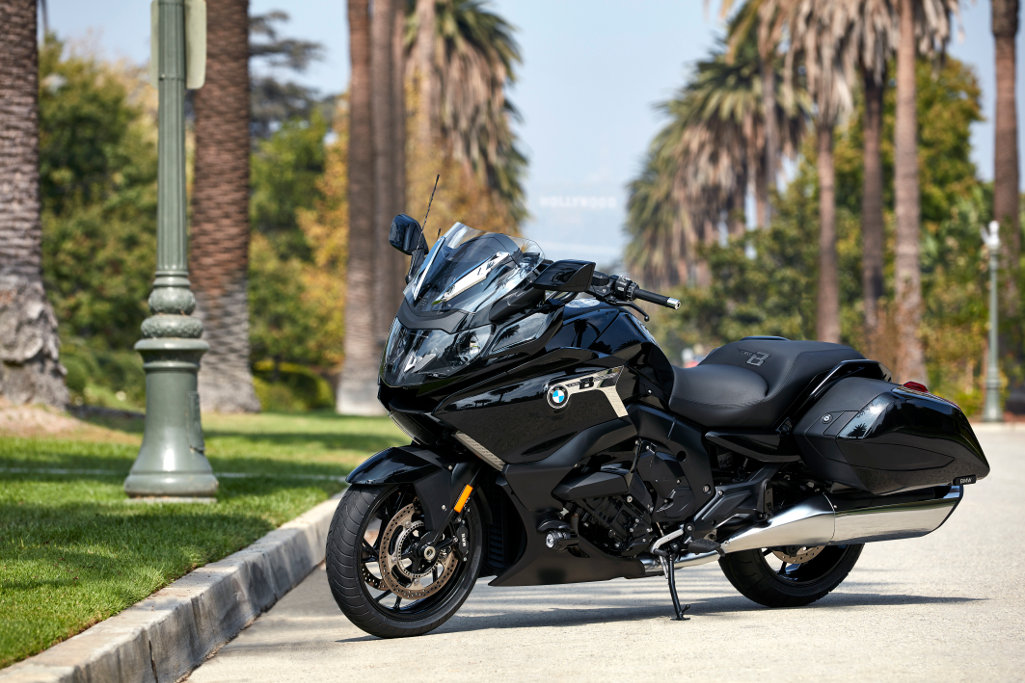 Its front end is very similar to the GT’s apart from the shorter screen, which is electronically adjustable and can be replaced by the taller version as an option. The fairing incorporates the hand-adjustable, ear-like wind deflectors that were introduced with the GT. The lower section is cut away, allowing fitment of forward-set foot-boards, though the GT fairing’s storage compartments can be added instead, as another of numerous factory options.
Its front end is very similar to the GT’s apart from the shorter screen, which is electronically adjustable and can be replaced by the taller version as an option. The fairing incorporates the hand-adjustable, ear-like wind deflectors that were introduced with the GT. The lower section is cut away, allowing fitment of forward-set foot-boards, though the GT fairing’s storage compartments can be added instead, as another of numerous factory options.
There’s more change at the rear end, where a lower subframe allows a seat height of 780mm against the GT’s adjustable 810-830mm. There’s a comparable reduction for the pillion who, like the rider, gets a generous amount of real estate on the stepped, one-piece seat. The panniers are similar in size, and big enough to allow most full-face helmets, but are non-removable because in bagger fashion they incorporate the rear light systems for a cleaner look. The rear mudguard hinges to allow rear-wheel removal.
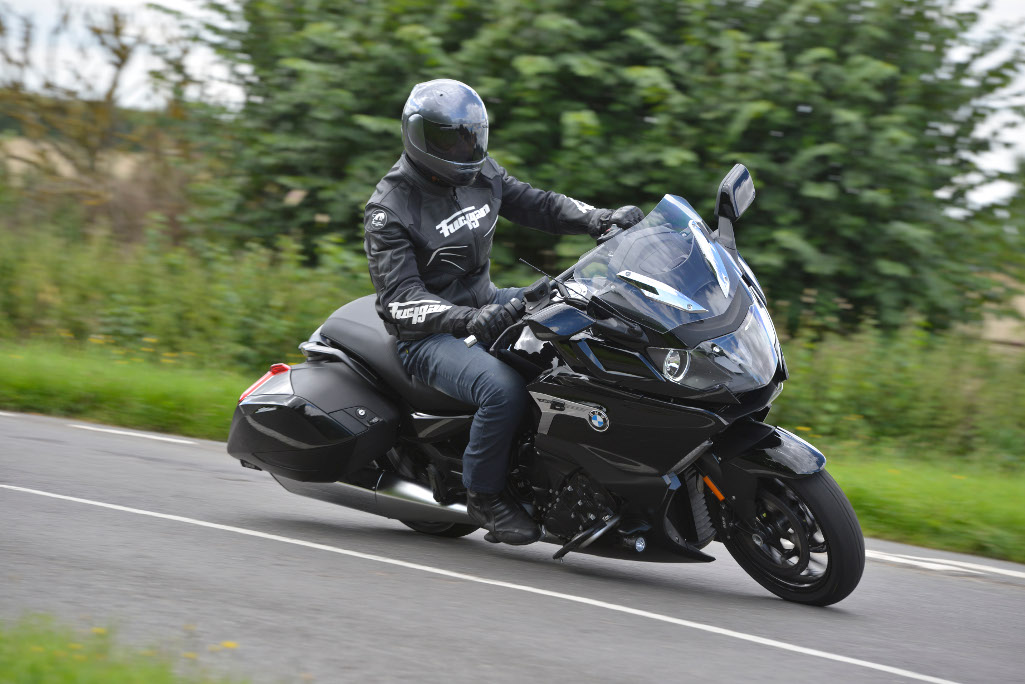 The mighty 1649cc, 24-valve engine appears in unchanged form, its new twin-silencer exhaust system not changing the maximum output of 158bhp at 7750rpm. As with the GT, it comes with three riding modes (labelled Rain, Road and Dynamic) adjustable via a button on the right bar, each with dedicated setting for the traction control system. It also shares the factory-fit options of reverse gear and two-way quick-shifter for the shaft-drive transmission’s six-speed box.
The mighty 1649cc, 24-valve engine appears in unchanged form, its new twin-silencer exhaust system not changing the maximum output of 158bhp at 7750rpm. As with the GT, it comes with three riding modes (labelled Rain, Road and Dynamic) adjustable via a button on the right bar, each with dedicated setting for the traction control system. It also shares the factory-fit options of reverse gear and two-way quick-shifter for the shaft-drive transmission’s six-speed box.
So far, so much like the GT, then. But shorter riders, in particular, are likely to find the bagger notably more manageable than the sports-tourer, due to its 300kg-plus weight being lower to the ground. For such a big bike it was certainly very easy to balance and steer at low speed, aided also by its lengthy wheelbase. And the test-bike’s reverse gear, activated by pressing the starter button, soon came in handy for manoeuvring out of a parking space.
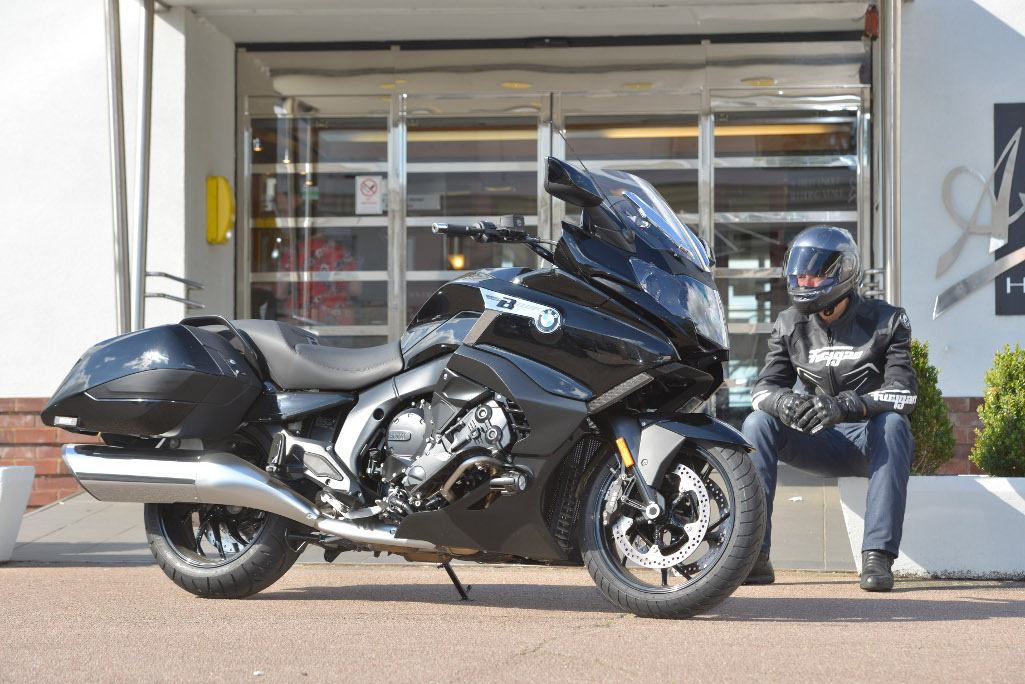 Once under way the sensations were almost identical to those I recall from riding the GT. That stomp-pulling six-cylinder engine takes centre stage in every way. It’s not just the sheer force of the acceleration, which seemed to keep on coming in a creamy-smooth surge whether I short-shifted through the box or held the revs towards the 8500rpm redline. The distinctive straight-six character added to the entertainment, as did the addictive purr and occasional crackle from the chrome-finished, slash-cut silencers.
Once under way the sensations were almost identical to those I recall from riding the GT. That stomp-pulling six-cylinder engine takes centre stage in every way. It’s not just the sheer force of the acceleration, which seemed to keep on coming in a creamy-smooth surge whether I short-shifted through the box or held the revs towards the 8500rpm redline. The distinctive straight-six character added to the entertainment, as did the addictive purr and occasional crackle from the chrome-finished, slash-cut silencers.
On a dry day the Dynamic riding mode was smooth enough that I rarely bothered with Road (let alone Rain), but for town use the softer option would be worthwhile, if only for its automatically recalibrated traction control system. Given that the mighty motor grunts out 70 per cent of its vast, 175N.m torque max from as low as 1500rpm, use of the gearbox is almost optional but not to be missed. The two-way shifter was generally a joy to use, though a couple of times it required a second press of the lever to engage on downshifts, as I recall the GT’s also doing.
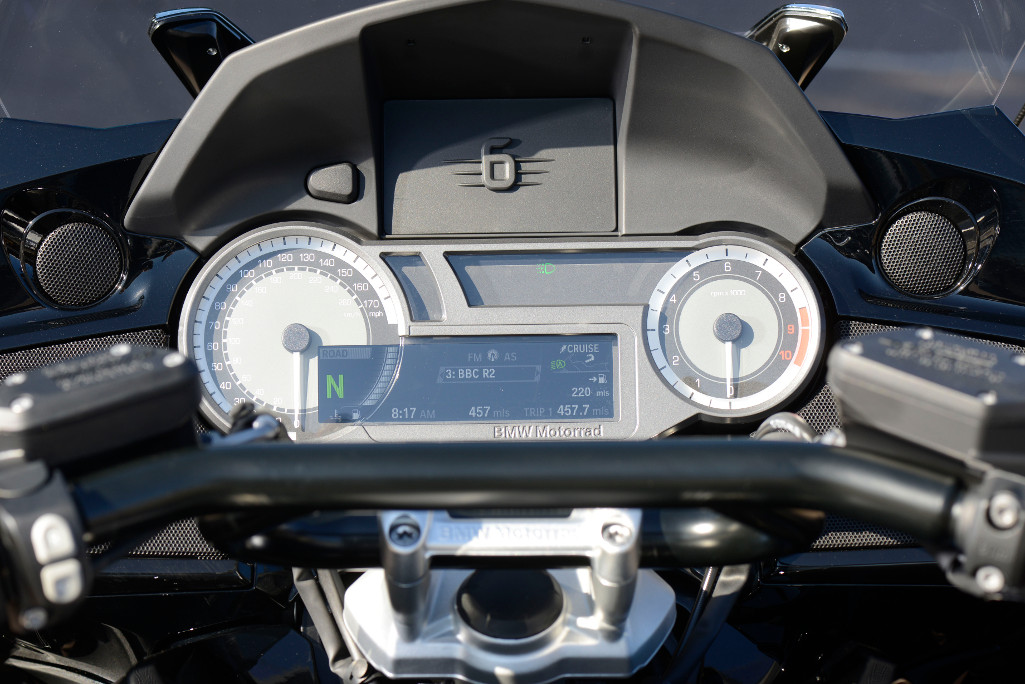 Also helping make the performance very useable was the substantial wind protection, which doesn’t quite match the GT’s but still gave a very relaxing ride. Despite being tall, I found the shorter screen usefully protective and fairly turbulence-free on its highest setting, although I couldn’t hear the sound system clearly at cruising speeds. For long distances, especially on a motorway, I’d prefer the taller GT screen but normal height riders might disagree.
Also helping make the performance very useable was the substantial wind protection, which doesn’t quite match the GT’s but still gave a very relaxing ride. Despite being tall, I found the shorter screen usefully protective and fairly turbulence-free on its highest setting, although I couldn’t hear the sound system clearly at cruising speeds. For long distances, especially on a motorway, I’d prefer the taller GT screen but normal height riders might disagree.
Whether to opt for the test-bike’s footboards or stick to the GT’s fairing lowers would be another tricky decision. The extra storage space, which includes an electrical socket (relocated to a pouch in a pannier on this bike), would sometimes be useful, but on a long motorway trip I’d also appreciate the chance to rest my feel further forward. On normal roads I rarely bothered with the foot-boards, because you can’t use the gearlever or rear brake. The stopper is however also operated by the handlebar lever, via a linked system.
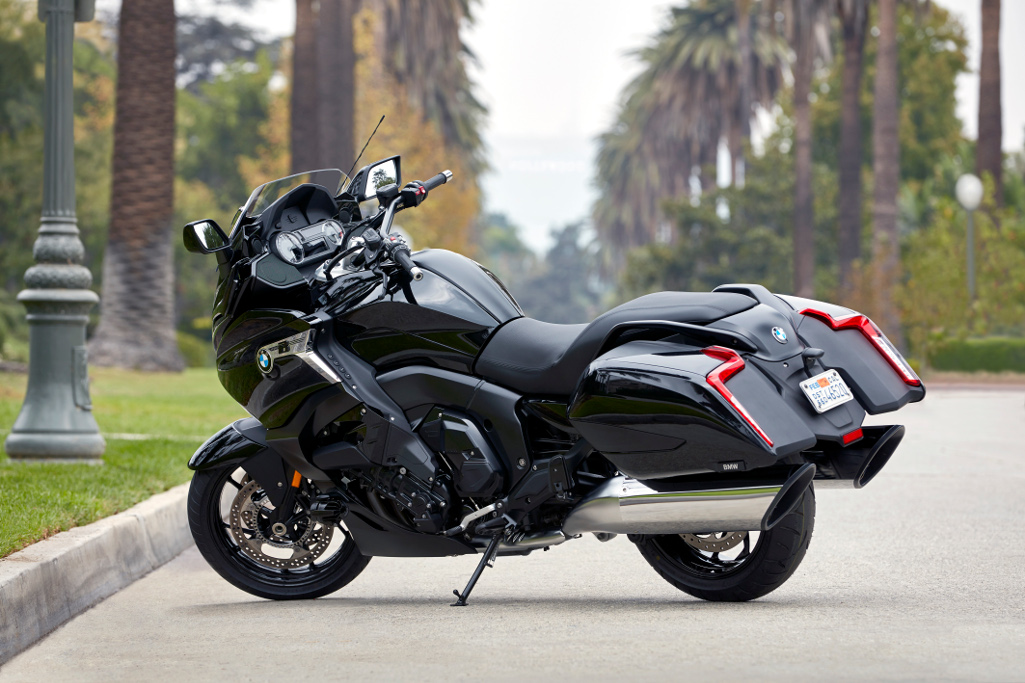 Decisions, decisions. Choosing which of the two modes to select for the Dynamic ESA suspension system, on the other hand, was easy. The standard Road setting gave a good blend of respectably supple ride quality and taut damping. I kept the BMW on that setting for most of the day because the softer Cruise setting, easily activated on the move via the click-wheel on the left bar, gave a much more vague feel. It would be okay on a long motorway trip, at least with a light load, but was under-damped for even moderately hard riding.
Decisions, decisions. Choosing which of the two modes to select for the Dynamic ESA suspension system, on the other hand, was easy. The standard Road setting gave a good blend of respectably supple ride quality and taut damping. I kept the BMW on that setting for most of the day because the softer Cruise setting, easily activated on the move via the click-wheel on the left bar, gave a much more vague feel. It would be okay on a long motorway trip, at least with a light load, but was under-damped for even moderately hard riding.
The K1600B’s suspension, like that of the GT, also allows electronic shock preload adjustment, but doesn’t adjust automatically to suit load in the way that the latest R1200GS’s Dynamic ESA system does. It’s still a pretty sophisticated set-up, continually varying the front Duolever and rear Paralever units’ damping depending on whether the bike is accelerating, slowing or maintaining a steady pace.
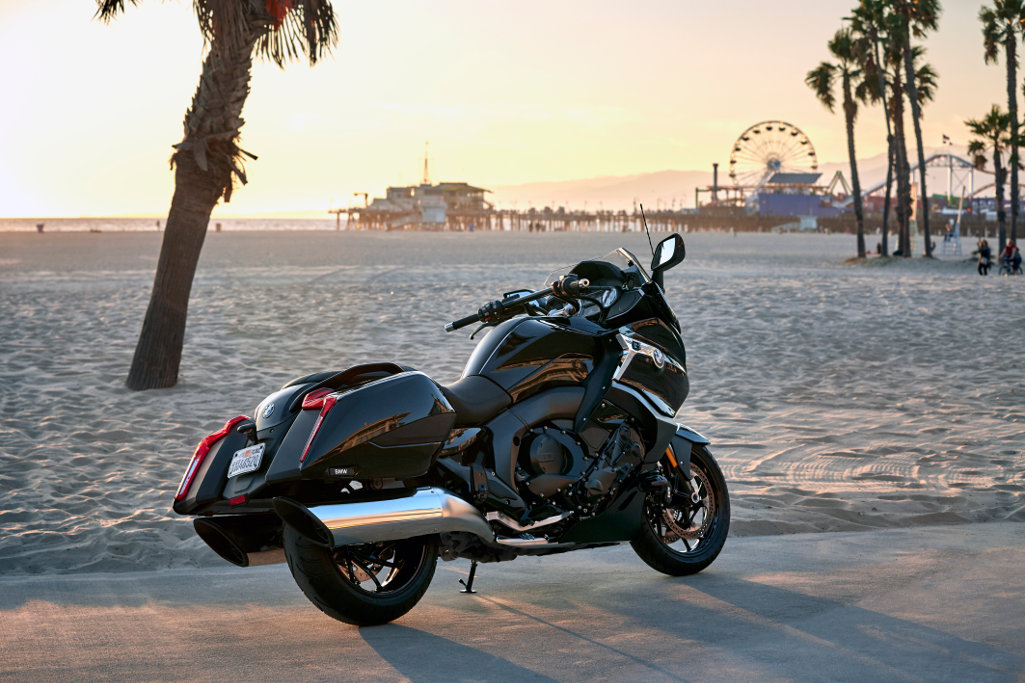 The suspension’s control helped make the K1600B impressively agile for a long bike that weighs over 330kg with fuel. The BMW demolished smooth main-road curves effortlessly and was fine on bumpier back-roads, despite having only 125mm of rear shock travel against the GT’s 135mm. It even showed respectably generous ground clearance when the Bridgestone BT22s were working hard in turns, where the forward-set footboards’ deliberately sticking-out scraper pegs were first to touch down.
The suspension’s control helped make the K1600B impressively agile for a long bike that weighs over 330kg with fuel. The BMW demolished smooth main-road curves effortlessly and was fine on bumpier back-roads, despite having only 125mm of rear shock travel against the GT’s 135mm. It even showed respectably generous ground clearance when the Bridgestone BT22s were working hard in turns, where the forward-set footboards’ deliberately sticking-out scraper pegs were first to touch down.
That helped make the B-bike fun to ride hard on a twisty road, despite its size and weight. As with the K1600GT, its front brake blend of four-piston calipers and 320mm discs gave powerful stopping, backed up by the linked, same-sized rear disc plus an efficient ABS system. Being so low-slung does the BMW no harm, either. Given that the bike slows as hard as it accelerates, it’s just as well that the pillion gets substantial grab-handles on each side.
Like other baggers including Indian’s Chieftain, Honda’s CTX1300 and the Harley Street Glide that began the trend, the K1600B makes a stylish and slightly more rider-friendly alternative to a full-blown tourer, especially for riders who don’t need to carry a pillion. For those who do, the extra wind protection and luggage-carrying potential of the GT, or even the fully-equipped GTL, would probably make more sense.
B-bike Options
Like most large-capacity BMWs, the K1600B comes in with a long list of options, which in some markets are combined to create a family of models. Standard features include xenon headlights, heated grips and seat, cruise control and the multi-controller ring. In the UK, the popular options of adaptive headlight, daytime running light, centre-stand, hill start control and tyre pressure monitor are added to created the K1600B SE.
Most B-bike buyers are also likely to want the audio system and reverse gear options, which are included to give the UK-market’s top-spec model, the K1600B LE. The test bikes included all those options plus footboards, crash-bars and the Comfort Plus package of keyless ignition, gearshift assist pro, central locking, LED fog lights and alarm. In total, that added just over 25 per cent to the price of the base-model K1600B.
| BMW K1600B
|
|
| Engine type | Liquid-cooled transverse six |
| Valve arrangement | DOHC, 24 valves |
| Displacement | 1649cc |
| Bore x stroke | 72 x 67.5mm |
| Compression ratio | 12.2:1 |
| Carburation | electronic fuel-injection |
| Clutch | Wet multiplate |
| Transmission | 6-speed |
| Maximum power | 158bhp (160.5PS) @ 7750rpm |
| Maximum torque | 175N.m @ 5250rpm |
| Front suspension | Duolever twin strut, 115mm travel, Dynamic-ESA semi-active |
| Rear suspension | Paralever system with single shock, 125mm wheel travel, Dynamic-ESA semi-active |
| Front brake | 2, radial four-piston calipers, 320mm discs with integral ABS |
| Rear brake | Twin-piston caliper, 320mm disc with integral ABS |
| Front wheel | 3.50 x 17in; cast aluminium |
| Rear wheel | 6.00 x 17in; cast aluminium |
| Front tyre | 120/70 x 17in Metzeler Roadtec |
| Rear tyre | 190/55 x 17in Metzeler Roadtec |
| Rake/trail | 27.8 degrees/106.4mm |
| Wheelbase | 1618mm |
| Seat height | 780mm |
| Fuel capacity | 26.5 litres |
| Kerb weight | 336kg “fully fuelled” |



